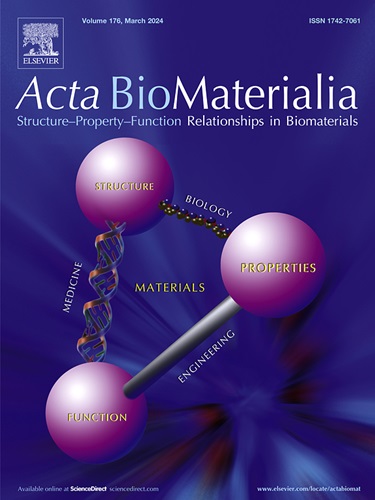Mechanosensing alters platelet migration
IF 9.4
1区 医学
Q1 ENGINEERING, BIOMEDICAL
引用次数: 0
Abstract
Platelets have long been established as a safeguard of our vascular system. Recently, haptotactic platelet migration has been discovered as a part of the immune response. In addition, platelets exhibit mechanosensing properties, changing their behavior in response to the stiffness of the underlying substrate. However, the influence of substrate stiffness on platelet migration behavior remains elusive. Here, we investigated the migration of platelets on fibrinogen-coated polydimethylsiloxane (PDMS) substrates with different stiffnesses. Using phase-contrast and fluorescence microscopy as well as a deep-learning neural network, we tracked single migrating platelets and measured their migration distance and velocity. We found that platelets migrated on stiff PDMS substrates (E = 2 MPa), while they did not migrate on soft PDMS substrates (E = 5 kPa). Platelets migrated also on PDMS substrates with intermediate stiffness (E = 100 kPa), but their velocity and the fraction of migrating platelets were diminished compared to platelets on stiff PDMS substrates. The straightness of platelet migration, however, was not significantly influenced by substrate stiffness. We used scanning ion conductance microscopy (SICM) to image the three-dimensional shape of migrating platelets, finding that platelets on soft substrates did not show the polarization and shape change associated with migration. Furthermore, the fibrinogen density gradient, which is generated by migrating platelets, was reduced for platelets on soft substrates. Our work demonstrates that substrate stiffness, and thus platelet mechanosensing, influences platelet migration. Substrate stiffness for optimal platelet migration is quite high (>100 kPa) in comparison to other cell types, with possible implications on platelet behavior in inflammatory and injured tissue.
Statement of Significance
Platelets can feel and react to the stiffness of their surroundings - a process called mechanosensation. Additionally, platelets migrate via substrate-bound fibrinogen as part of the innate immune response during injury or inflammation. It has been shown that the migration of immune cells is influenced by the stiffness of the underlying substrate, but the effect of substrate stiffness on the migration of platelets has not yet been investigated. Using differently stiff substrates made from PDMS, we show that substrate stiffness affects platelet migration. Stiff substrates facilitate fast and frequent platelet migration with a strong platelet shape anisotropy and a strong fibrinogen removal while soft substrates inhibit platelet migration. These findings highlight the influence of the stiffness of the surrounding tissue on the platelet immune response, possibly enhancing platelet migration in inflamed tissue.

机械感应改变血小板迁移。
血小板长期以来一直被认为是我们血管系统的保障。最近,血小板触致性迁移被发现是免疫反应的一部分。此外,血小板表现出机械传感特性,根据底层基质的刚度改变其行为。然而,衬底刚度对血小板迁移行为的影响仍然难以捉摸。在这里,我们研究了血小板在不同硬度的纤维蛋白原包被聚二甲基硅氧烷(PDMS)基质上的迁移。利用相对比和荧光显微镜以及深度学习神经网络,我们跟踪了单个迁移血小板,并测量了它们的迁移距离和速度。我们发现血小板在坚硬的PDMS底物上迁移(E = 2 MPa),而在柔软的PDMS底物上不迁移(E = 5 kPa)。血小板在中等刚度的PDMS基质上也有迁移(E = 100 kPa),但它们的速度和迁移血小板的比例比在刚性PDMS基质上的血小板要小。然而,血小板迁移的直线度不受基体刚度的显著影响。我们使用扫描离子电导显微镜(SICM)对迁移血小板的三维形状进行成像,发现软基质上的血小板没有表现出与迁移相关的极化和形状变化。此外,由血小板迁移产生的纤维蛋白原密度梯度在软底物上降低。我们的工作表明,基底刚度,从而血小板机械感应,影响血小板迁移。与其他细胞类型相比,用于血小板迁移的底物刚度相当高(bbb100 kPa),这可能影响炎症和损伤组织中血小板的行为。意义说明:血小板能够感知周围环境的硬度并作出反应,这一过程被称为机械感觉。此外,在损伤或炎症期间,血小板通过底物结合纤维蛋白原作为先天免疫反应的一部分迁移。已有研究表明,免疫细胞的迁移受到底物硬度的影响,但底物硬度对血小板迁移的影响尚未得到研究。使用由PDMS制成的不同硬度的衬底,我们表明衬底刚度影响血小板迁移。硬底物具有较强的血小板形状各向异性和较强的纤维蛋白原去除能力,促进血小板快速频繁迁移,而软底物则抑制血小板迁移。这些发现强调了周围组织的硬度对血小板免疫反应的影响,可能会增强炎症组织中的血小板迁移。
本文章由计算机程序翻译,如有差异,请以英文原文为准。
求助全文
约1分钟内获得全文
求助全文
来源期刊

Acta Biomaterialia
工程技术-材料科学:生物材料
CiteScore
16.80
自引率
3.10%
发文量
776
审稿时长
30 days
期刊介绍:
Acta Biomaterialia is a monthly peer-reviewed scientific journal published by Elsevier. The journal was established in January 2005. The editor-in-chief is W.R. Wagner (University of Pittsburgh). The journal covers research in biomaterials science, including the interrelationship of biomaterial structure and function from macroscale to nanoscale. Topical coverage includes biomedical and biocompatible materials.
 求助内容:
求助内容: 应助结果提醒方式:
应助结果提醒方式:


